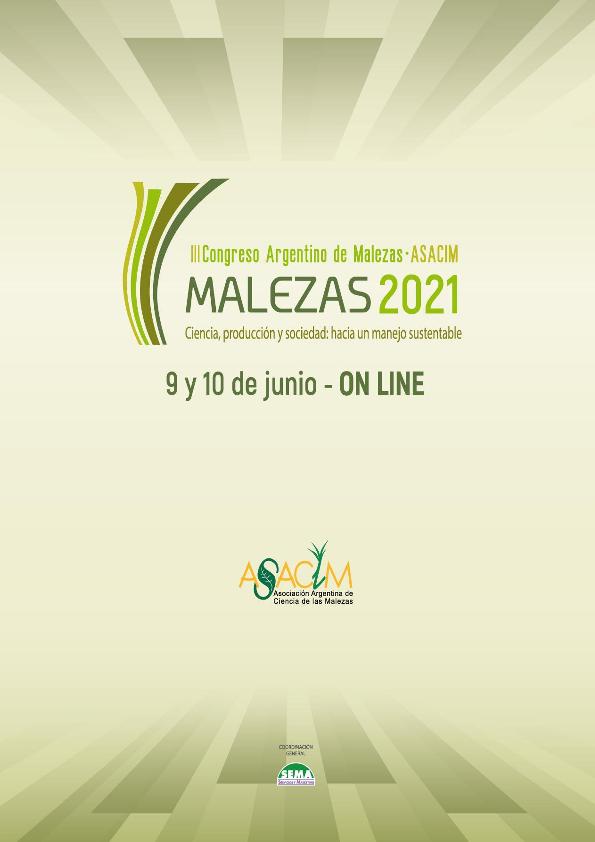Evento
Conyza sumatrensis ha incrementado su frecuencia en los agroecosistemas pampeanos, destacándose por su tolerancia a glifosato. Los cultivos de cobertura (CC) resultan una herramienta para su manejo, alternativa al uso de herbicidas. El objetivo del trabajo fue comparar el efecto supresivo de diferentes mezclas de CC sobre Conyza sumatrensis. En un experimento a campo se compararon tratamientos de barbecho químico (BQ) y diferentes CC: mezclas simples (MS) conformadas por gramíneas (avena ó centeno) y leguminosas (vicia villosa ó sativa), o mezclas complejas (MC) formadas por MS + colza. Mediante recuentos quincenales de plántulas de C. sumatrensis presentes en marcos fijos de 0,25 m2, se determinó densidad (pl.m-2) y tiempo medio de emergencia (TME). Se realizó un análisis de correlación simple (Pearson, P) entre los parámetros evaluados en la maleza y CC (biomasa y cobertura vegetal). Se aplicó un diseño en bloques completos al azar con cuatro repeticiones. El TME fue mayor (p=0,01) en CC respecto a BQ (62,1 vs 46,9 días), para densidad total (DT) no se observaron diferencias significativas. Las MC Centeno-V.villosa y Avena-V.sativa presentaron mayores TME (p=0,05) respecto de la MS y MC de Centeno-V.sativa (75,8 y 73,4 vs 52,1 y 50,8 días). Se encontró interacción (p=0,005) de gramínea-leguminosa, donde Centeno-V.villosa presentó mayor TME respecto de V.sativa (72,4 vs 51,4 días). Con V.sativa, Avena presentó mayores TME respecto de Centeno (65,3 vs 51,4 días) y, con V.villosa lo contrario (58,4 vs 72,4 días).En este punto, se encontró interacción (p=0,01) de leguminosa-colza para DT, la cual fue mayor con V.sativa en MC respecto de MS (pl.m2: 6,5 vs 1). Se halló correlación entre: TME-cobertura vegetal (P: 0,47), TME- % gramínea en la mezcla (P: -0,45) y DT-Biomasa del CC (P:-0,36). La composición de la mezcla y los parámetros del CC impactarían en la supresión de Conyza sumatrensis. Conyza sumatrensis has increased its frequency in agroecosystems of the Pampas region, standing out for its tolerance to glyphosate. Cover crops (CC) are interesting a tool for its management as an alternative to herbicides uses. The aim of this study was to compare the suppressive effect of different CC mixtures on C. sumatrensis. A field experiment compared chemical fallow (CF) treatments and different CC: simple mixtures (SM) consisting of grasses (oats or rye) and legumes (hairy or common vetch), or complex mixtures (CM) formed by SM+rapeseed. Fortnightly counts of C. sumatrensis seedling were performed in fixed 0, 25m2 frames, estimating density (pl.m-2 ) and average emergency time (AET).A simple correlation analysis (Pearson's coefficient, P) was carried out between the parameters evaluated in the weed and CC (biomass and vegetation cover). A randomized complete block design with four repetitions was used.AET was higher (p = 0.01) in CC compared to CF (62.1 vs 46.9 days), for total density (TD) no significant differences were found. The CM formed by rye- hairy vetch and oat-common vetch showed higher AET (p= 0.05) compared to the SM and CM of rye-common vetch (75.8 and 73.4 vs 51.45 days). Interaction (p = 0.005) of grass and legume was found, where rye-hairy vetch exhibited higher AET relative to common vetch (72.4 vs 51.4 days). With common vetch, oat AET was higher compared to rye (65.3 vs 51.4 days) and, lower compared with hairy vetch the opposite (58.4 vs 72.4 days). Interaction (p = 0.01) of legume-rapeseed for TDwas found, which was higher with common vetch in CM compared to SM (pl.m2 : 6.5 vs 1). Correlations were found between: TME-vegetation cover (P: 0.47), TME-% grass in the mixture (P: -0.45) and TD-CC biomass (P:-0.36). The composition of the mixture impacted on the suppression of CC on C. sumatrensis.
Cultivos de cobertura como estrategia de manejo de Conyza sumatrensis (Retz) E. Walker en el centro sur bonaerense
Tipo del evento:
Congreso
Nombre del evento:
III Congreso Argentino de Malezas
Fecha del evento:
09/06/2021
Institución Organizadora:
Asociación Argentina de la Ciencia de las Malezas;
Título del Libro:
III Congreso Argentino de Malezas: Ciencia, producción y sociedad: hacia un manejo sustentable
Editorial:
Asociación Argentina de la Ciencia de las Malezas
Idioma:
Español
Clasificación temática:
Resumen
Palabras clave:
MEZCLAS COMPLEJAS
,
MEZCLAS SIMPLES
,
AVENA
,
CENTENO
,
VICIA
Archivos asociados
Licencia
Identificadores
Colecciones
Eventos(CERZOS)
Eventos de CENTRO REC.NAT.RENOVABLES DE ZONA SEMIARIDA(I)
Eventos de CENTRO REC.NAT.RENOVABLES DE ZONA SEMIARIDA(I)
Citación
Cultivos de cobertura como estrategia de manejo de Conyza sumatrensis (Retz) E. Walker en el centro sur bonaerense; III Congreso Argentino de Malezas; Rosario; Argentina; 2021; 223-224
Compartir




